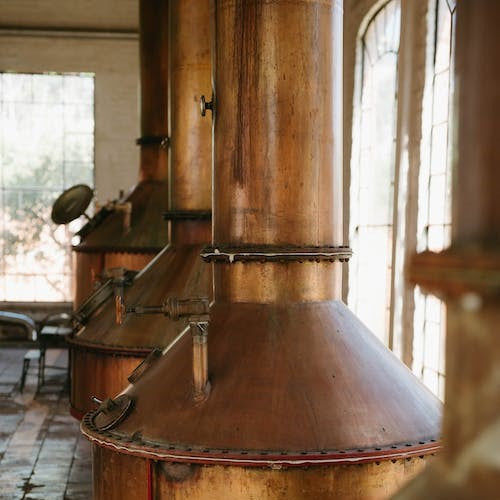Careful ingredient selection, expert fermentation, and precise distillation are the hallmarks of craft whiskey. Choosing the best still for whiskey production is a major decision for any distillery. The classic pot still and the more modern column still (or stack still) are two common choices. This article will compare and contrast pot stills and column stills, focusing on their respective merits and shortcomings when it comes to producing high-quality whiskey.
Column Stills vs. Pot Stills
The use of the pot still in the distillation of whiskey dates back centuries. The method of distillation was first invented in ancient civilizations, which is where its roots may be found. Copper pots or kettles with a swan neck are the core components of pot stills, which are batch distillation processes. Alcohol vapors ascend from the heated fermented mash, condense at the swan neck, and then drain into a receiver.
Distillation has been around for a while, but column stills, also called continuous stills or stack stills, are a relatively new invention. They allowed for constant production once they were introduced in the early 19th century. The plates or columns that make up a column still are placed vertically. Multiple distillations can be accomplished in a single run by continuously feeding fermented mash into the still and allowing steam to rise through the plates. The alcohol content increases and the efficiency of mass production improves with this procedure.
The Benefits and Drawbacks of Using Pot Stills to Make Craft Whiskey
Many small-batch whiskey distillers prefer pot stills because of the superior spirit quality they provide. Since pot stills allow for more precise control over the distillation process, the resulting spirit has more nuanced qualities. Whiskey manufacture also makes use of the copper used in pot stills. Copper's interaction with the vapor purges unwanted substances and makes for a higher-quality spirit.
The adaptability of pot stills is one of their primary benefits. The final product can be affected by the still's size and shape, which is why distillers use them. It's common knowledge that pot stills are used to distill high-quality, handcrafted whiskeys in limited quantities by dedicated distillers. They work wonderfully in the creation of robust alcoholic beverages that are full of flavor and scent.
However, there are a few limitations to using a pot still. In comparison to column stills, they typically have smaller production capacity, making them less suitable for large-scale operations. Pot stills take longer to complete the distillation process, which can add time and money to the manufacturing process. Furthermore, some distillers may perceive modest flavor changes from batch to batch as a beneficial attribute, while others may view it as a challenge to consistency due to the batch nature of pot stills.
The Benefits and Drawbacks of Using Column (Stack) Stills to Make Craft Whiskey
When it comes to productivity and scalability, column stills stand out as a clear winner. As a result of their continuous distillation method, a greater volume of whiskey may be produced. It is helpful for catering to consumer needs that high proof spirits can be produced in a single distillation operation.
Column stills can produce a spirit that is lighter and more neutral in flavor, which is another advantage. This can be a desirable quality in whiskeys that have been blended or aged in barrels, since it highlights the whiskey's natural flavors and features. Column stills are commonly employed to distill blended whiskeys and cocktail spirits due to their reputation for producing a clean and smooth spirit. There are benefits to using column stills for making handmade whiskey, but there are also drawbacks. Their lack of complexity and depth of flavor compared to pot-distilled whiskeys is a common complaint. Some of the congeners and aromatic chemicals that give whiskey its unique flavor are often lost during the continuous distillation process used by column stills. Because of this, the resulting vibe may seem less unique or generic.
In addition, unlike pot stills, column stills don't allow for as much manipulation during the distillation process. Since the process is always running, there is no time for adjustments or tweaks. Pot stills are generally the preferred apparatus of craft distillers who place a premium on producing high-quality, individually crafted spirits.
The final decision between a pot still and a column still should be based on the distiller's aims and ethos. The goal of making artisan whiskey is to make something special, something that captures the essence of the ingredients and the skill that went into making it. Pot stills allow for a more hands-on, nuanced approach that can produce spirits with extraordinary character and complexity, while column stills are efficient and scalable.
In the end, both pot stills and column stills have their advantages and disadvantages when it comes to making handmade whiskey. Whiskeys made in small batches by skilled distillers using pot stills are known for their unique character. They let you have more leeway and command, but at the expense of your factory's productivity. On the other hand, column stills have earned a stellar reputation for their scalability and capacity to generate massive quantities of high-proof spirits. They are often criticized for their apparent lack of complexity, despite the fact that they produce whiskeys that are lighter and more neutral.
Ultimately, the goals of the distiller, the intended flavor profile, and the scale of production will determine the still that will be used. Craft whiskey is a product of the dedication, skill, and creativity of distillers who take great care in choosing the right still in order to produce premium spirits that are enjoyed by both whiskey novices and aficionados. Whatever the method of distillation used—pot still or column still—craft whiskey continues to push the envelope of flavor and creativity, resulting in an ever-expanding selection of truly remarkable libations.
